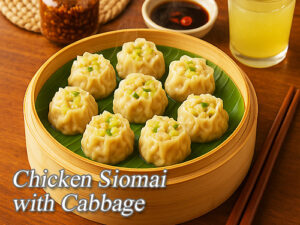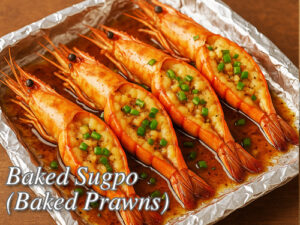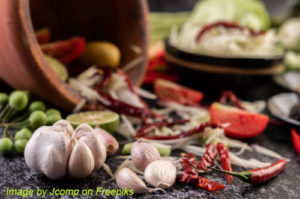Dumplings is an Asian dimsum appetizer and it is very similar to siomai. They can be steamed or fried depending on your preference. This prawn and spring onion dumpling recipe I have is steamed and composed of prawns and spring onion and of course some spices and flavorings. You can also use chives which is very similar to spring onion in appearance and taste. Spring onions is readily available than chives so I prefer to use it than chives.
Prawn and Spring Onion Dumplings
Back when I was in high school, my cousin Marites would visit us from Binondo every summer. She was the kind of ate who always had something good tucked in her luggage—dried mangoes from Cebu, hopia from Ongpin, and once, a tiny bamboo steamer filled with freshly made dumplings wrapped in banana leaves. I still remember the aroma when she opened it—savory, a bit sweet, and a hit of sesame that made us all rush to the kitchen before the batch disappeared. That was my first taste of prawn and spring onion dumplings—and it was love at first bite.
Why This Dumpling Dish Deserves a Spot in Your Kitchen
Dumplings are the comfort food of Asia. From Japanese gyoza to Korean mandu and our own Pinoy-style siomai, these little parcels of joy have traveled far and wide. This particular recipe, made with prawns and fresh spring onions, is a close cousin of siomai—but with a lighter, sweeter seafood profile that’s perfect for beginners and seasoned home cooks alike.
In our family, this has become a go-to for birthdays, rainy days, or any weekend when we feel like steaming something special. It’s easy enough for anyone to try, but flavorful enough to keep making over and over.
Fresh Ingredients Make the Difference
I learned the hard way that frozen shrimp just doesn’t cut it. My Uncle Benjie, who runs a small karinderya in Lucena, insisted that I try using fresh prawns from the local palengke. “Mas buhay ang lasa,” he told me. He was right.
Chopped spring onions—sometimes mistaken for chives—bring a mild oniony zing that complements the natural sweetness of the prawns. They’re easier to find in most local groceries, and frankly, they hold up better in the mix. When combined with a touch of garlic, soy sauce, and sesame oil, the result is a juicy filling that bursts with umami in every bite.
A Technique That Works Every Time
Here’s something my sister Grace taught me: when mixing the filling, stir it in one direction—clockwise, always clockwise. I used to laugh at her for being so superstitious about it, but it turns out there’s a science behind the method. Mixing in one direction helps the proteins in the prawns bind better with the starch and egg, making the filling cohesive and springy rather than loose or crumbly.
Another tip? Don’t overstuff the wrappers. A teaspoon is just right. Too much filling makes them hard to seal and even harder to steam evenly. And when sealing, wet the edges just enough to make them sticky—too much water and the wrapper gets slippery, not sticky.
Steamed, Not Fried
While many people enjoy fried dumplings for the crispy skin, this version is steamed to preserve the soft, delicate texture of the wrapper and the juicy filling inside. It takes only about eight minutes in the steamer, and you’ll know they’re done when the wrappers turn slightly translucent and the scent hits your nose like a savory cloud.
To serve, we usually mix soy sauce and calamansi juice for dipping. It’s a sharp, salty-sour combo that cuts through the richness of the prawns. Some days we throw in a bit of chili oil when we’re feeling bold.
The Story Behind Dumplings
Dumplings have deep roots across Asia, but did you know the idea of wrapping meat in dough and steaming it dates back over a thousand years? The Chinese legend says a healer named Zhang Zhongjing created them during a harsh winter to help people fight frostbite—stuffed with warming herbs and meats, and wrapped to look like ears. Over time, the humble dumpling transformed into a symbol of prosperity, especially during Lunar New Year.
In the Philippines, we’ve made dumplings our own—adding calamansi, adjusting seasonings to suit local palates, and often using what’s readily available. That’s what I love most about our food—it’s never rigid. It adapts to what we have, where we are, and who we’re sharing it with.
Make It Your Own
What I’m sharing here is just one version of prawn and spring onion dumplings. Once you’ve tried it a couple of times, don’t be afraid to play around. Sometimes I add a bit of minced carrots for crunch. My niece Liza, who’s studying in Davao, even adds grated ginger to give it some warmth.
The beauty of this dish is that it welcomes your personal touch. But if it’s your first time making dumplings, stick to this base recipe and learn the rhythm. Once you’ve mastered it, you’ll find yourself wrapping and sealing like you were born doing it.
So go ahead, steam a batch today. Let your kitchen fill with the scent of sesame and soy. And maybe—just maybe—start a new family tradition, one dumpling at a time.
How to Cook Prawn and Spring Onion Dumplings
Ingredients
- 1/2 kilo prawns peeled and coarsely chopped
- 1/4 cup chopped spring onions
- 2 tsp. grated onion
- 1/2 Tbsp. crushed garlic
- 2 Tbsp cornstarch
- 1 Tbsp. light soy sauce
- 2 tsp. sesame oil
- 1 egg
- wonton wrappers round shape
- water for brushing
For the dipping sauce:
- 1/4 cup soy sauce
- 2 Tbsp. calamansi juice
Instructions
How to make Prawn and Spring Onion Dumplings:
- In a bowl, mix well to combine the prawns, onions, garlic, cornstarch, soy sauce, sesame oil and egg.
- Place a teaspoonful of prawn mixture into each wonton wrapper.
- Brush edges with water. Fold in half and press edges of wonton wrappers to seal.
- Fold edges lightly to create pleat design. Place in steamer and steam for about 8 minutes or until prawns are cooked and wrappers are tender.
- In a small bowl, combine soy sauce and calamansi juice. Serve as dipping sauce for the dumplings.
Notes
Cooking Tips:
Use Fresh Prawns for Better Flavor and Texture
Fresh prawns give the filling a naturally sweet, clean taste that frozen ones just can’t match. They also provide a firmer bite, which helps the dumplings hold their shape after steaming. If using frozen prawns, make sure to thaw them completely and pat them dry to avoid watery filling.Don’t Overfill the Dumpling Wrapper
A heaping teaspoon of filling is enough to prevent the dumplings from bursting or becoming too dense. Too much filling makes it harder to seal and may cause uneven cooking during steaming. Keeping the size uniform also ensures all your dumplings cook evenly at the same time.Seal Dumplings Tightly and Pleat for Structure
Always moisten the edges of the wrapper with water to help it seal securely and avoid leaks while steaming. Pleating adds both visual appeal and a better structure, so the wrapper stays in place as it cooks. Press firmly but gently when sealing to keep the filling intact without tearing the wrapper.





Hi! Can I use stall bought dumpling skin (nit homemade) to make this? How many can I make with this recipe? Thanks
Yes you can use the store bought dumpling skin.